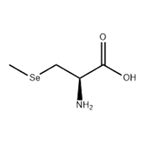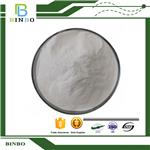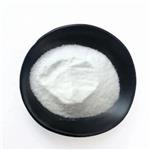Se-methyl selenocysteine (MSC) is a naturally occurring selenium compoundwith favourable pharmacokinetic properties andth high peroral bioavailability in humans. MSC is synthesized by plants such as garlic, astragalus, onions and broccoli. Se-methylselenocysteine has been proven to have a chemo-preventive property, which is shown by several authors via various cell culture models and animal models. It has also been shown to have anti-carcinogenic properties by inducing cell cycle arrest and apoptotic cell death. It is considered a pro-drug because the compound per se is not toxic unless it is metabolized by the enzymes Kynurenine aminotransferase 1 (KYAT1), Kynurenine aminotransferase 3 (KYAT3) and cystathionine γ-lyase (CTH). Of these, KYAT1 plays a vital role in MSC metabolism.
white to slightly yellow powder
2-Amino-3-methylselenyl propionic acid is an inhibitor of DMBA-induced mammary tumors.
ChEBI: Se-methyl-L-selenocysteine is an L-alpha-amino acid compound having methylselanylmethyl as the side-chain. It has a role as an antineoplastic agent. It is a Se-methylselenocysteine, a non-proteinogenic L-alpha-amino acid and a L-selenocysteine derivative. It is a conjugate base of a Se-methyl-L-selenocysteinium. It is a conjugate acid of a Se-methyl-L-selenocysteinate. It is an enantiomer of a Se-methyl-D-selenocysteine. It is a tautomer of a Se-methyl-L-selenocysteine zwitterion.
Se-methylselenocysteine (MSC) is a naturally occurring selenium compound with favorable pharmacokinetic properties and high peroral bioavailability in humans. MSC has been proven to have a chemo-preventive property, which several authors show via various cell culture models and animal models. It has also been shown to have anti-carcinogenic properties by inducing cell cycle arrest and apoptotic cell death. It is considered a pro-drug because the compound per se is not toxic unless it is metabolized by the enzymes Kynurenine aminotransferase 1 (KYAT1), Kynurenine aminotransferase 3 (KYAT3) and cystathionine γ-lyase (CTH). Of these, KYAT1 plays a vital role in MSC metabolism. KYAT1 is a PLP dependent enzyme whose main function is to cleave carbon-sulfur bonds. KYAT is a bi-functional enzyme that catalyzes transamination and β-elimination reactions with single substrates. KYAT1 metabolizes MSC into β-methylselenopyruvate (MSP) and methylselenol via transamination and β-elimination catalysis.
Se-Methylselenocysteine (MSC) is a selenium (Se) supplement with antioxidant and anticancer effects, and its efficacy and safety are superior to selenomethionine supplements. However, Se may cause toxic reactions. Long-term dietary intake of Se compounds (500 μg Se per day) may cause adverse reactions such as endocrine disruption, immunity modulation, hepatotoxicity, and amyotrophic lateral sclerosis in humans. The acceptable daily intake (ADI) of MSC in human diet is estimated to be 3.4 μg/kg BW/day. MSC is reported to be less toxic and more bioactive than inorganic or other organic Se compounds. The reason may be that selenomethionine is nonspecifically incorporated into proteins as the amino acid methionine and further provides reversible Se storage in organs and tissues, while MSC is not easily incorporated into proteins and accumulates in the free pool after ingestion[1].
[1] HUI YANG Xudong J. Safety evaluation of Se-methylselenocysteine as nutritional selenium supplement: Acute toxicity, genotoxicity and subchronic toxicity[J]. Regulatory Toxicology and Pharmacology, 2014, 70 3: Pages 720-727. DOI:10.1016/j.yrtph.2014.10.014.



